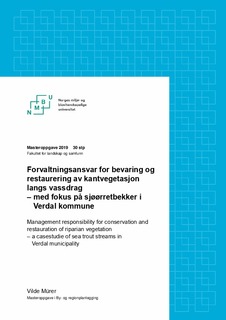| dc.contributor.advisor | Stokke, Knut Bjørn | |
| dc.contributor.advisor | Stensland, Stian | |
| dc.contributor.author | Mürer, Vilde | |
| dc.coverage.spatial | Norway, Verdal | nb_NO |
| dc.date.accessioned | 2019-08-22T08:20:28Z | |
| dc.date.available | 2019-08-22T08:20:28Z | |
| dc.date.issued | 2019 | |
| dc.identifier.uri | http://hdl.handle.net/11250/2609762 | |
| dc.description.abstract | Kantvegetasjon har en viktig funksjon i vassdragets økosystem. Naturlig vegetasjon langs vassdrag er levested for fugler og annet dyreliv. For livet i vannet, vil kantvegetasjonen utgjøre skygge og skjul for fisk, samt tilførsel av næring fra innsekter og dødt plantemateriale. Der det er jordbruksland mot vassdraget, vil kantvegetasjonen gi vern mot erosjon og næringsavrenning. Det beskytter vassdraget mot eutrofiering og holder jorda på plass.
Kantvegetasjonen er ivaretatt i en rekke lover og forskrifter, men det foretas likevel ulovlig hogst. Det vil ta mange år før kantvegetasjonen vokser tilbake, og igjen kan utgjøre den funksjonen den skal ha i og rundt vassdraget. Med VRL - 2000 § 11 skulle opprettholdelse av kantvegetasjonen sikres for å ivareta de økologiske funksjonene. Paragrafen legger opp til en ansvarsfordeling mellom grunneier, kommuner, fylkesmannen og Norges vassdrags- og energidirektorat (NVE). Det har likevel vært usikkerhet rundt hvordan ansvarsfordelingen skal forstås, og hvordan lovverket som setter rammer for tiltak skal tolkes. Derfor utarbeidet NVE en veileder som skal synliggjøre ansvarsfordelingen og myndighetsutøvelsen i forvaltningen av kantvegetasjon.
I denne oppgaven har jeg undersøkt hvordan kantvegetasjon blir ivaretatt i Verdal kommune. Hovedmålet har vært å finne ut hvordan fylkesmannen i Trøndelag, NVE, og Verdal kommune har tolket lovverket og ansvarsfordelingen. Studien diskuterer også hvordan grunneiere og lokale aktører kan inngå i et samarbeid med offentlige aktører i forvaltningen av kantvegetasjon og sjøørretbekker. Jeg har brukt kvalitativ metode med intervjuer og dokumentstudier.
Resultatene viser at det er bevissthet rundt ansvarsfordelingen etter lovverket, men det mangler samordning mellom ulike sektorer og etater som har innvirkning på kantvegetasjonen langs vassdrag. I tillegg er ulovlighetsoppfølging etter vrl. § 11 lite brukt. Kommunens rolle etter vrl. § 11 blir passiv, og kommuneplanens arealdel bør være førende for forvaltningen av kantvegetasjonen. Bevaring og restaurering av kantvegetasjon vil være avhengig av at offentlige og lokale aktører kan samarbeide, dette for å komme frem til felles forvaltningsstrategier og bestemmelser. | nb_NO |
| dc.description.abstract | Riparian vegetation has an important function in the ecosystem of waterways. The natural vegetation alongside water systems is a habitat for birds and other fauna. For life in these waterways, the vegetation provides shadows, protection and an important source of nutrition from insects and dead plant material. Where agricultural land borders the waterways, this vegetation protects against erosion and fertilization runoff by keeping the earth stable and preventing eutrophication.
Riparian vegetation is protected by a multitude of laws and regulations, but illegal clearing of this flora still occurs. Regrowth of the riparian zones can take many years before it regains its natural functions in and around the waterways. The VRL - 2000 § 11 law was created to ensure conservation of riparian zones and the ecological functions that it provides. This paragraph details a distribution of responsibilities between landowners, municipalities, county governors and the Norwegian Water Resources and Energy Directorate (NVE). Despite this, there has been uncertainty about how the distribution of responsibility, and the legislation regarding initiative and action should be interpreted. Because of this confusion, NVE created a guide that displays the distribution of responsibility and the execution of authority regarding the management of riparian vegetation.
Within this study I have explored how riparian vegetation is conserved in Verdal Municipality. My main goal has been to explore how the county governor in Trøndelag, the NVE and Verdal Municipality have interpreted the laws and distribution of responsibility. This study also explores how landowners and stakeholders can begin to cooperate with public bodies on conserving the riparian vegetation and the sea trout streams. I have used qualitative research methods through interviews and the study of documentation.
The results show an awareness of the responsibility required by the legislation, but there is a lack of coordination between different sectors and estates that have influence over the riparian vegetation. In addition, the sanctions of VRL § 11 are seldom applied. The role of the municipality with regards to VRL § 11 is passive, and the municipal planning of land-use should be more directed towards conservation. Conservation and restoration of riparian vegetation is dependent on the cooperation of public and local bodies, and these different participants must reach agreement on common strategies and decisions. | nb_NO |
| dc.description.sponsorship | Verdal kommunes sjøørretfond ; NMBU småforskmidler ; Fylkesmannen i Nord-Trøndelag ; Statens Vegvesen ; Miljødirektoratet. | nb_NO |
| dc.language.iso | nob | nb_NO |
| dc.publisher | Norwegian University of Life Sciences, Ås | nb_NO |
| dc.rights | Attribution-NonCommercial-NoDerivatives 4.0 Internasjonal | * |
| dc.rights.uri | http://creativecommons.org/licenses/by-nc-nd/4.0/deed.no | * |
| dc.subject | Kantvegetasjon | nb_NO |
| dc.subject | Vannressursloven § 11 | nb_NO |
| dc.subject | Samarbeid | nb_NO |
| dc.subject | Verdalsvassdraget | nb_NO |
| dc.subject | Ansvarsfordeling | nb_NO |
| dc.subject | Forvaltning | nb_NO |
| dc.title | Forvaltningsansvar for bevaring og restaurering av kantvegetasjon langs vassdrag : med fokus på sjøørretbekker i Verdal kommune | nb_NO |
| dc.title.alternative | Management responsibility for conservation and restauration of riparian vegetation : a casestudie of sea trout streams in Verdal municipality | nb_NO |
| dc.type | Master thesis | nb_NO |
| dc.subject.nsi | VDP::Samfunnsvitenskap: 200::Urbanisme og fysisk planlegging: 230::Romlig, territoriell planlegging: 238 | nb_NO |
| dc.subject.nsi | VDP::Samfunnsvitenskap: 200::Rettsvitenskap: 340::Miljørett: 347 | nb_NO |
| dc.source.pagenumber | 78 | nb_NO |
| dc.description.localcode | M-BYREG | nb_NO |

